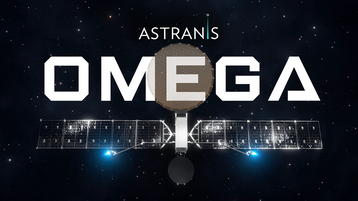Geostationary satellite firm Astranis has announced a new, larger version of its MicroGEO communications satellite.
“Today, we are excited to announce our next-generation product — Astranis Omega — a broadband communications system with better pound-for-pound performance than any other geostationary satellite in orbit today,” John Gedmark, Astranis co-founder and CEO.
Founded in 2015, Astranis develops what it describes as MicroGEO satellites; geostationary satellites far smaller than traditional GEO machines that provide capacity for a targeted area, such as a single country.
Its existing machines currently weigh around 400kg and offer 10-12 Gbps of throughput; traditional GEO satellites often weigh multiple tons, though often for far higher capacity offering far wider coverage areas with 20+ year lifespans.
The company said the new 600kg Omega satellites will offer 50+ Gbps of throughput per satellite while maintaining a small satellite form factor.
“We will still build them in less than 18 months; we will still maneuver our satellites on orbit; we will still operate our satellites for 8-10 years,” said Gedmark.
Gedmark told SpaceNews the company developing two versions of Omega: A dual-use satellite using commercial and military Ka-band frequencies, and a military-only version on X-band.
SpaceNews said Omega will use Astranis-designed semiconductors to produce high-power radio frequency signals, instead of vacuum tubes used by traditional geostationary satellites.
The first Omega satellites are set to launch in 2026.
Astranis said around half of the company’s first satellite was built in-house; the most recent satellites coming off of the line are closer to 60 percent; and Omega will be about 70 percent built in-house.
In April 2023, the company successfully launched its first commercial satellite, Arcturus, into orbit to provide Internet to Alaska for local telco Pacific Dataport.
The machine was set to offer 7.5Gbps of throughput in the Ka-band. However, an issue with the system that controls the satellite’s solar panels means it doesn’t have enough power to provide constant connectivity services.
Though the company is in control of the satellite, Astranis estimates it can only get six to 12 hours a day of service from the spacecraft. The company said the malfunctioning spacecraft could still be used as an in-orbit test bed or another alternative mission.
While a replacement machine is due to launch in 2025, the company aims to supplement the compromised satellite with a UtilitySat; a multi-mission commercial microGEO satellite the company said was capable of conducting multiple fully-operational broadband connectivity missions.
Astranis recently announced its Arcturus satellite will be temporarily moved from Alaska to Asia for use by Israeli satellite operator Spacecom to meet a regulatory deadline for bringing the position into use.
Despite the initial setback, Astranis has a backlog of customers. The company is to launch a dedicated MicroGEO satellite for Argentina in partnership with LATAM ISP Orbith. Thaicom has also ordered a GEO satellite from Astranis to launch in 2025.
It also has plans to launch two satellites over the Philippines in 2024 with local telco Orbits Corp, with an additional two satellites set to launch for Mexican firm Apco Networks.
US-based mobile satellite connectivity specialist Anuvu (again for two machines) and Peruvian cellular backhaul provider Andesat have also ordered satellites from Astranis.
In other recent satellite news:
– Intelsat is in talks with the US government to help fund its plans to deploy 17 medium Earth orbit (MEO) satellites.
– Safran Data Systems is to supply Swedish Space Corporation (SSC) with an optical ground station designed to support Earth-space communications. The ground station will be installed in Chile at the end of this year.
– L3Harris Technologies has signed a five-year deal to use Iridium’s Satellite Time and Location (STL) service. Iridium will provide the STL service to more than three dozen L3Harris-operated communications network backbone nodes and a similar number of Federal Aviation Administration (FAA) facilities throughout the United States.
– Kacific is collaborating with Microsoft’s Airband initiative to connect 750 rural educational and healthcare institutions across developing countries in the Asia Pacific using Ka-band beams from the Kacific-1 satellite.
– Submarine cable network operator Seacom has launched a low-earth-orbit (LEO) satellite service for its enterprise clients in South Africa.
– Small satellite maker Aerospacelab has acquired AMOS, a Belgian provider of optics for spacecraft and ground-based telescopes.
– Gilat has announced that a ‘leading IFC Service Provider’ has signed a multimillion-dollar order for Gilat’s Taurus platform.
– Commercial space station developer Vast will use SpaceX’s Starlink for connectivity. The company will utilize Starlink for broadband connectivity aboard its Haven-1 station, launching next year.
– Starlink has launched in Albania.







